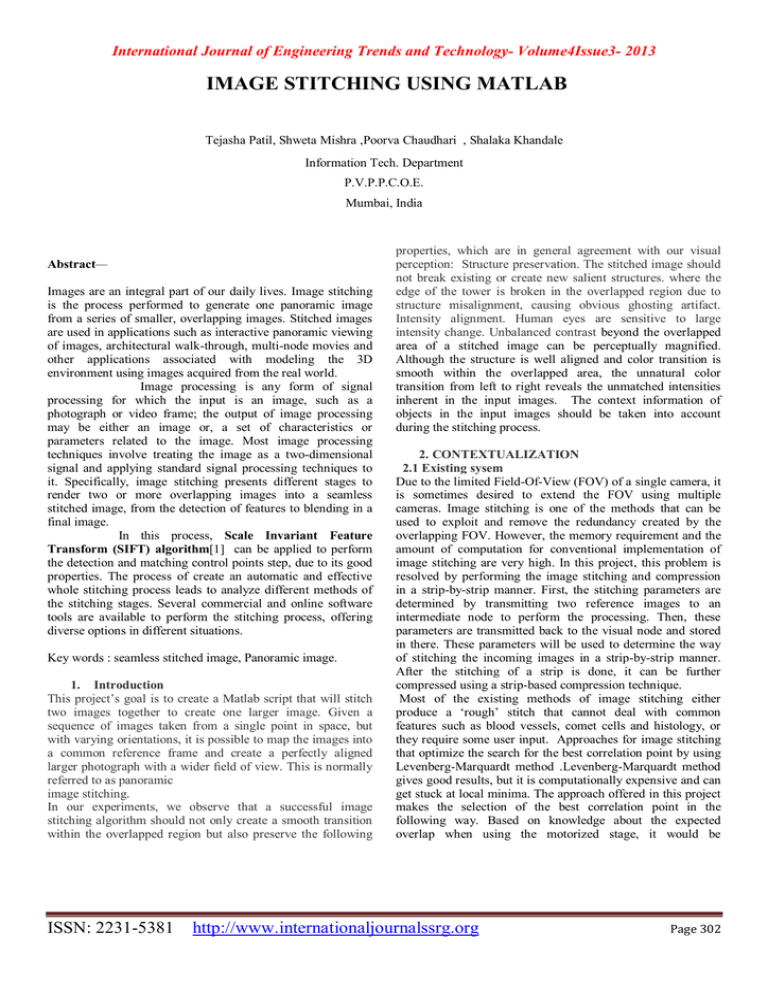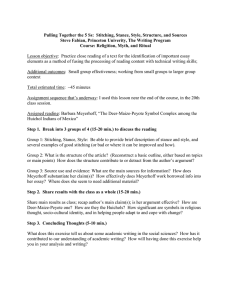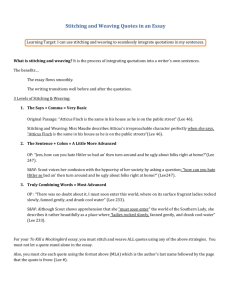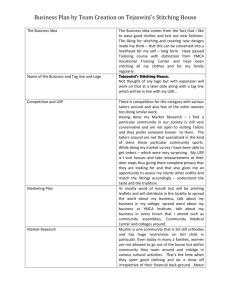IMAGE STITCHING USING MATLAB
advertisement

International Journal of Engineering Trends and Technology- Volume4Issue3- 2013 IMAGE STITCHING USING MATLAB Tejasha Patil, Shweta Mishra ,Poorva Chaudhari , Shalaka Khandale Information Tech. Department P.V.P.P.C.O.E. Mumbai, India Abstract— Images are an integral part of our daily lives. Image stitching is the process performed to generate one panoramic image from a series of smaller, overlapping images. Stitched images are used in applications such as interactive panoramic viewing of images, architectural walk-through, multi-node movies and other applications associated with modeling the 3D environment using images acquired from the real world. Image processing is any form of signal processing for which the input is an image, such as a photograph or video frame; the output of image processing may be either an image or, a set of characteristics or parameters related to the image. Most image processing techniques involve treating the image as a two-dimensional signal and applying standard signal processing techniques to it. Specifically, image stitching presents different stages to render two or more overlapping images into a seamless stitched image, from the detection of features to blending in a final image. In this process, Scale Invariant Feature Transform (SIFT) algorithm[1] can be applied to perform the detection and matching control points step, due to its good properties. The process of create an automatic and effective whole stitching process leads to analyze different methods of the stitching stages. Several commercial and online software tools are available to perform the stitching process, offering diverse options in different situations. Key words : seamless stitched image, Panoramic image. 1. Introduction This project’s goal is to create a Matlab script that will stitch two images together to create one larger image. Given a sequence of images taken from a single point in space, but with varying orientations, it is possible to map the images into a common reference frame and create a perfectly aligned larger photograph with a wider field of view. This is normally referred to as panoramic image stitching. In our experiments, we observe that a successful image stitching algorithm should not only create a smooth transition within the overlapped region but also preserve the following ISSN: 2231-5381 properties, which are in general agreement with our visual perception: Structure preservation. The stitched image should not break existing or create new salient structures. where the edge of the tower is broken in the overlapped region due to structure misalignment, causing obvious ghosting artifact. Intensity alignment. Human eyes are sensitive to large intensity change. Unbalanced contrast beyond the overlapped area of a stitched image can be perceptually magnified. Although the structure is well aligned and color transition is smooth within the overlapped area, the unnatural color transition from left to right reveals the unmatched intensities inherent in the input images. The context information of objects in the input images should be taken into account during the stitching process. 2. CONTEXTUALIZATION 2.1 Existing sysem Due to the limited Field-Of-View (FOV) of a single camera, it is sometimes desired to extend the FOV using multiple cameras. Image stitching is one of the methods that can be used to exploit and remove the redundancy created by the overlapping FOV. However, the memory requirement and the amount of computation for conventional implementation of image stitching are very high. In this project, this problem is resolved by performing the image stitching and compression in a strip-by-strip manner. First, the stitching parameters are determined by transmitting two reference images to an intermediate node to perform the processing. Then, these parameters are transmitted back to the visual node and stored in there. These parameters will be used to determine the way of stitching the incoming images in a strip-by-strip manner. After the stitching of a strip is done, it can be further compressed using a strip-based compression technique. Most of the existing methods of image stitching either produce a ‘rough’ stitch that cannot deal with common features such as blood vessels, comet cells and histology, or they require some user input. Approaches for image stitching that optimize the search for the best correlation point by using Levenberg-Marquardt method .Levenberg-Marquardt method gives good results, but it is computationally expensive and can get stuck at local minima. The approach offered in this project makes the selection of the best correlation point in the following way. Based on knowledge about the expected overlap when using the motorized stage, it would be http://www.internationaljournalssrg.org Page 302 International Journal of Engineering Trends and Technology- Volume4Issue3- 2013 straightforward to find the best correlation point in the ideal case. However, the overlap area is not perfect, and certainly not to an accuracy of one pixel, due to deviations in stage position from the ideal and due to stage/camera misalignment. Our algorithm offers a way to overcome this problem by searching the small area around the expected central overlap pixel in order to find the best correlation point. Positioning of acquired images with a manual stage is much less accurate, so there is a need to search a wider area in order to find the best cross-correlation point. This project’s goal is to create a Matlab script that will stitch two images together to create one larger image. Image stitching has wide uses in photo applications and has become a required toolset for many photographers. These stitched images, become panoramic views which increase the visual aesthetics of a scene, and are widely sought out for posters, postcards, and other printed materials. This project will be performed using point correspondences between the two images and utilizing Matlab’s Image Processing Toolbox. 2.2 Proposed System Image processing can be defined as analysis of picture using techniques that can basically identify shades and colors. It deals with images in bitmapped graphic format that have been scanned or captured with digital camera. It also means image improvement, such as refining a picture in a program or software that has been scanned or entered from a video source or in short, image processing is any form of information processing when both the input and output is images. Image processing is divided into two major branches; image enhancement and image restoration. Image enhancement is to improve the quality of image or emphasize particular aspects within image and to produce image that is different from the original. Whereas image restoration, is to recover the original image after degraded by known effects such as geometric distortion within camera system. Image processing does not reduce the amount of data present but rearranges it. Spatial filtering : An image can be filtered to remove a band of spatial frequencies, such as high frequencies and low frequencies. Where rapid brightness transitions are established, high frequencies will be there. In the other hand, slowly changing brightness transitions represent low frequencies. The highest frequencies normally will be found at the sharp edges or points. Spatial filtering operations include high pass, low pass and edge detection filters. High pass filters accentuate the high frequency details of image and attenuate the low frequency, creating a sharpening effect. Sharpening : The main aim in image sharpening is to highlight fine detail in the image, or to enhance detail that has been blurred due to noise or other effects. Sharpening emphasizes edges in the image and make them easier to see and recognize. In creating a sharpened image, no new details are actually created. The nature of sharpening is is influenced by the blurring radius used. In addition to that, differences between each pixel and its neigbour too, can influence sharpening effect. Blurring : ISSN: 2231-5381 The visual effect of a low pass filter is image blurring. This is because the sharp brightness transitions had been attenuated to small brightness transitions. It have less detail and blurry. Blurring can be done in spatial domain by pixel averaging in a neighbor. Blurring is aimed to diminish the effects of camera noise, unauthentic pixel values or missing pixel values. For blurring effect, there are two mostly used techniques which are neighbourhood averaging (Gaussian filters) and edge preserving (median filters). The blurring effect can improve an image’s low frequency details by removing visually disruptive high frequency patterns. By subtracting a low pass filtered image from the original image, a sharpened image can be created. The latter operation is known as unsharp masking enhancement. Edge detection : Edges are often used in image analysis for finding region boundaries. They are pixels where brightness changes abruptly. An edge essentially distinguishes between two distinctly different regions or in short, an edge is the border between two different regions. Robert operator, Sobel operator, Prewitt operator, Canny operator and Krish operator are among edge detectors that are often used. Edge detection of an image reduces significantly the amount of data and filters out information that may be regarded as less relevant, preserving the important structural properties of an image. There are many methods for edge detection, but most of them can be grouped into two categories, search-based and zerocrossing based. The 3 important stages in the process of stitching images are: 1.Image Acquisition: The images that need to be stitched are acquired using a camera mounted on a tripod stand. The camera angle is varied to take different overlapping sample images. 2.Image Registration: The process of image registration aims to find the translations to align two or more overlapping images such that the projection from the view point through any position in the aligned images into the 3D world is unique. Image Registration consists of four main components: Feature set- The set of features includes the intensity values, contours, textures and so on. A feature set must be selected for each image registration method. Similarity measure- It is a function which returns a scalar value that provides an indication of the similarities between two features. Search set- It is a set of possible transformations for aligning the images. Search strategy- It is the algorithm that decides how to select the next transformations from the search set. Techniques used: 1) Registration using a different feature set. 2) Registration using different similarity measures. 3) Registration with step search strategy. 3) Image Merging: Image merging is the process of adjusting the values of pixels in two registered images, such that when the images are joined, the transition from one image to the next is invisible. It should also ensure that the new image has a quality http://www.internationaljournalssrg.org Page 303 International Journal of Engineering Trends and Technology- Volume4Issue3- 2013 comparable to that of the original images used. Image merging can be carried out by making the seam invisible in the output image. The seam is the line that is visible at the point where the two images overlap. Techniques used: 1) Linear distribution of intensity differences 2) Linear distribution of median intensity differences 3) Intensity adjustment with respect to corresponding pixels in overlapping region. Steps for Image Sitching : the purpose of object recognition is proposed. The main idea is to divide the features extracted from both the test and the model object image into several sub-collections before they are matched. The features are divided into several subcollections considering the features arising from different octaves, that is from different frequency domains. [1] Following are the major stages of computation used to generate the set of image features: 1. Scale-space extrema detection: The first stage of computation searches over all scales and image locations. It is implemented efficiently by using a difference-of-Gaussian function to identify potential interest points that are invariant to scale and orientation. 2. Keypoint localization: At each candidate location, a detailed model is fit to determine location and scale. Keypoints are selected based on measures of their stability. 3. Orientation assignment: One or more orientations are assigned to each keypoint location based on local image gradient directions. All future operations are performed on image data that has been transformed relative to the assigned orientation, scale, and location for each feature, thereby providing invariance to these transformations. 4. Keypoint descriptor: The local image gradients are measured at the selected scale in the region around each keypoint. These are transformed into a representation that allows for significant levels of local shape distortion and change in illumination. This approach has been named the Scale Invariant Feature Transform (SIFT), as it transforms image data into scaleinvariant coordinates relative to local features. [4] RANdom SAmple Consensus algorithm The Random sample Consensus algorithm (RANSAC) proposed by Fischler and Bolles is a general parameter estimation approach designed to cope with a large proportion of outliers in the input data. Unlike many of the common robust estimation techniques such as M-estimators and leastmedian squares that have been adopted by the computer vision community from the statistics literature, RANSAC was developed from within the computer vision community. RANSAC is a resampling technique that generates candidate solutions by using the minimum number observations (data points) required to estimate the underlying model parameters. As pointed out by Fischler and Bolles , unlike conventional sampling techniques that use as much of the data as possible to obtain an initial solution and then proceed to prune outliers, RANSAC uses the smallest set possible and proceeds to enlarge this set with consistent data points. The basic algorithm is summarized as follows: 3. Methodology Scale Invarient Feature Algorithm The SIFT algorithm (Scale Invariant Feature Transform) proposed by Lowe is an approach for extracting distinctive invariant features from images. It has been successfully applied to a variety of computer vision problems based on feature matching including object recognition, pose estimation, image retrieval and many others. However, in realworld applications there is still a need for improvement of the algorithm’s robustness with respect to the correct matching of SIFT features. In this paper, an improvement of the original SIFT algorithm providing more reliable feature matching for ISSN: 2231-5381 1) Select randomly the minimum number of points required to determine the model parameters. 2) Solve for the parameters of the model. 3) Determine how many points from the set of all points fit with a predefined tolerance . 4) If the fraction of the number of inliers over the total number points in the set exceeds a predefined threshold τ , re-estimate the model parameters using all the identified inliers and terminate. 5) Otherwise, repeat steps 1 through 4 (maximum of N times). http://www.internationaljournalssrg.org Page 304 International Journal of Engineering Trends and Technology- Volume4Issue3- 2013 An advantage of RANSAC is its ability to do robust estimation of the model parameters, i.e., it can estimate the parameters with a high degree of accuracy even when a significant number of outliers are present in the data set. A disadvantage of RANSAC is that there is no upper bound on the time it takes to compute these parameters. When the number of iterations computed is limited the solution obtained may not be optimal, and it may not even be one that fits the data in a good way. In this way RANSAC offers a trade-off; by computing a greater number of iterations the probability of a reasonable model being produced is increased. Another disadvantage of RANSAC is that it requires the setting of problem-specific thresholds. RANSAC can only estimate one model for a particular data set. As for any one-model approach when two (or more) model instances exist, RANSAC may fail to find either one. The Hough transform is an alternative robust estimation technique that may be useful when more than one model instance is present. [3]. The figure below depicts keypoint detection. 4. CONCLUSION In this paper, we have proposed a novel image-matching algorithm. Our algorithm can significantly increase the number of matching pairs, and matching accuracy. Extensive experimental results show that our method improves the traditional detectors, even in large variations, and the new indicators are distinctive. The image stitcher provides a cost effective and flexible alternative to acquire panoramic images using a panoramic camera. The panoramic images stitched by a stitcher can also be used in applications where the camera is unable to obtain a full view of the object of interest. The full view of the object can be constructed using the image stitcher using overlapping regional images acquired for the object. 5. ACKNOWLEDGEMENT This paper describes research done at PVPPCOE in the Department of Information Technology. We are thankful to Mrs. Sonali Pakhmode for guiding us. 3. PRELIMINARY RESULTS In this paper, we have proposed a novel image stitching approach by image deformation, where the overlapped regions may contain significant intensity inconsistency and geometrical misalignment. The below example depicts two geometrically misaligned images stitched in a panorama using MATLAB. 6. References [1] Y. Yu, K. Huang, and T. Tan, “A Harris-like scale invariant feature detector,” in Proc. Asian Conf. Comput. Vis., 2009, pp. 586–595. [2] J. M. Morel and G. Yu, “Asift: A new framework for fully affine invariant image comparison,” SIAM J. Imag. Sci., vol. 2, no. 2, pp. 438–469, Apr. 2009. [3] J. Rabin, J. Delon, Y. Gousseau, and L. Moisan, “RANSAC: A robust algorithm for the recognition of multiple objects,” in Proc. 3D’PVT, 2010. [4] M. Krulakova, Matrix technique of image processing in Matlab, ICCC'2010: proceedings of 11th International Carpathian Control Conference, 26-28 May, 2010, Eger, Hungary, Rekatel 2010, pp. 203-206, ISBN 978-963-06-92892. ISSN: 2231-5381 http://www.internationaljournalssrg.org Page 305 International Journal of Engineering Trends and Technology- Volume4Issue3- 2013 [5] Wei Xu and Jane Mulligan. Performance evaluation of color correction approaches for automatic multi-view image stitching. In 2010 IEEE Conference on Computer Vision and Pattern Recognition (CVPR 2010), pages 263 - 270, San Francisco, CA, USA, June 2010. [6] Oliver Whyte, Josef Sivic1, Andrew Zisserman, and Jean Ponce. Nonuniform deblurring for shaken images. In 2010 IEEE Conference on Computer Vision and Pattern Recognition (CVPR 2010), pages 491 - 498, San Francisco, CA, USA, June 2010. [7] Xianyong Fang, Bin Luo, Haifeng Zhao, Jin Tang, Biao He, and Hao Wu. A new multi-resolution image stitching with local and global alignment. IET Computer Vision, 2010. [8] MathWorks, MATLAB Builder JA 2 user's guide. [online] August 18, 2010 [cited 12.01.2011] available from 〈 http://www.mathworks.com/help/pdf-doc/ javabuilder/javabuilder.pdf〉. [9] MathWorks, Bringing java classes and methods into MATLAB workspace. [online] [cited 12.01.2011] available from 〈 http://www.mathworks.com/help/ techdoc/matlabexternal/f4863.html〉 [10] Chen Hui, Long AiQun, Peng YuHua. Building Panoramas from Photographs Taken with An Uncalibrated Hand-Held Camera. Chinese Journal of Computers, 2009,(2):328-335. [11] Hsieh, J.-W. Fast stitching algorithm for moving object detection and mosaic construction. in IEEE International Conference on Multimedia & Expo. 2003. Baltimore, Maryland, USA. ISSN: 2231-5381 http://www.internationaljournalssrg.org Page 306




